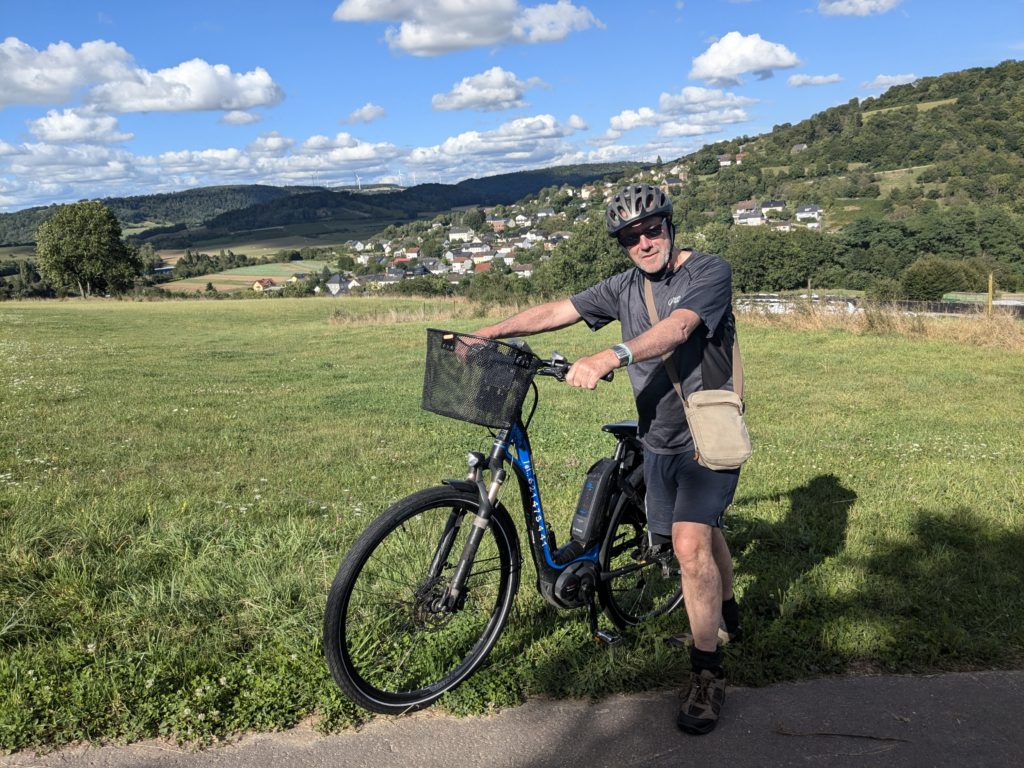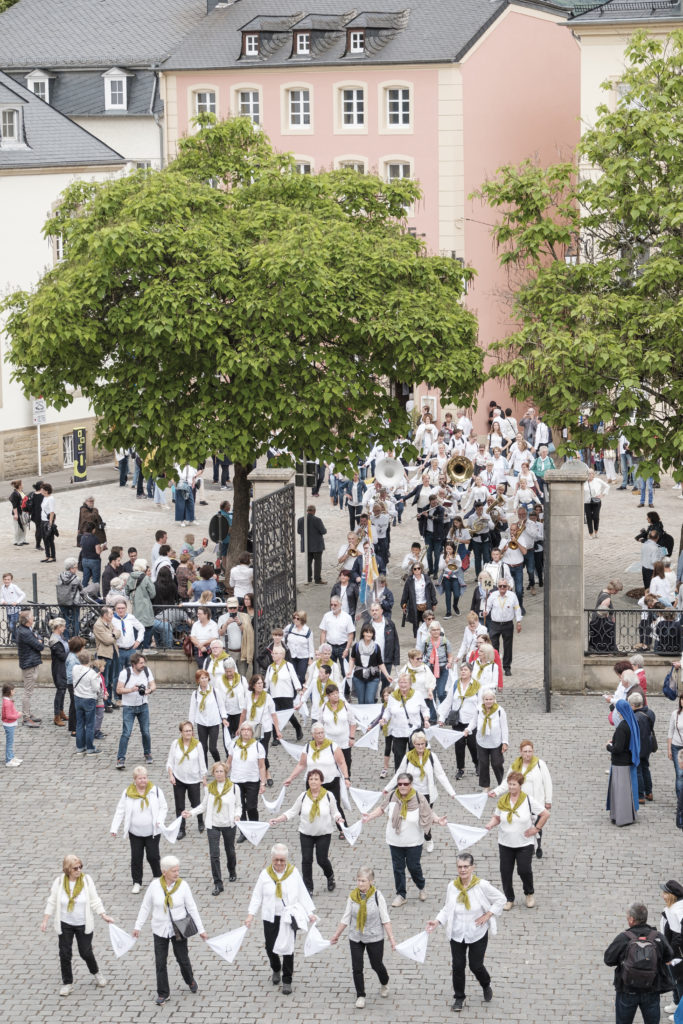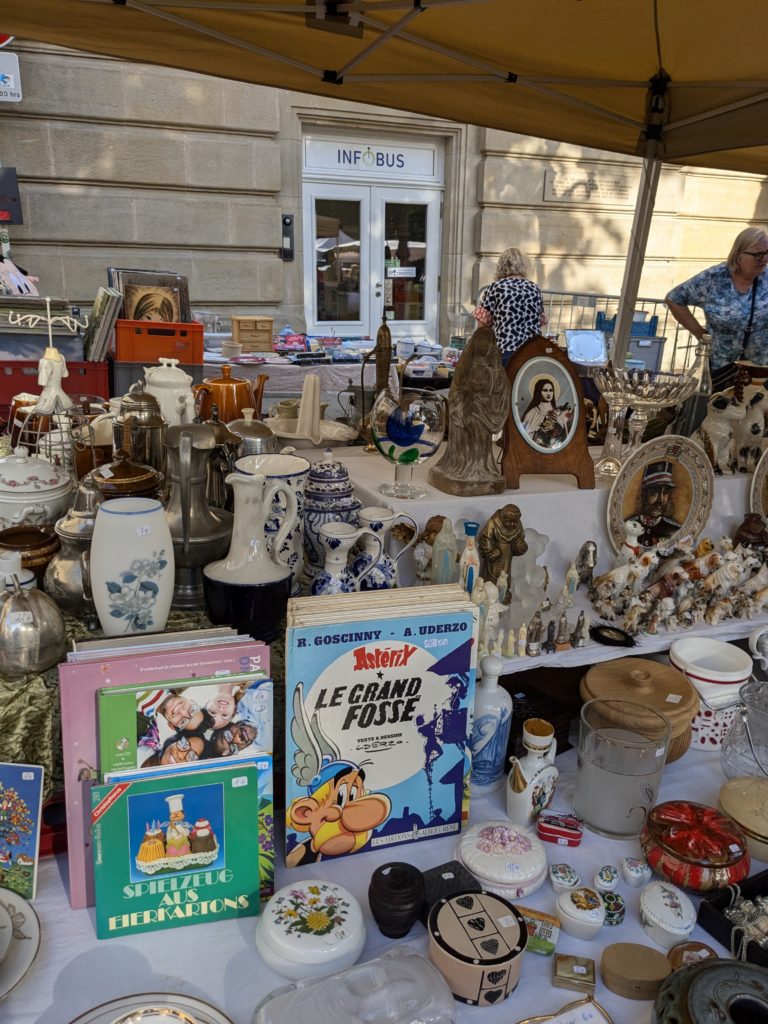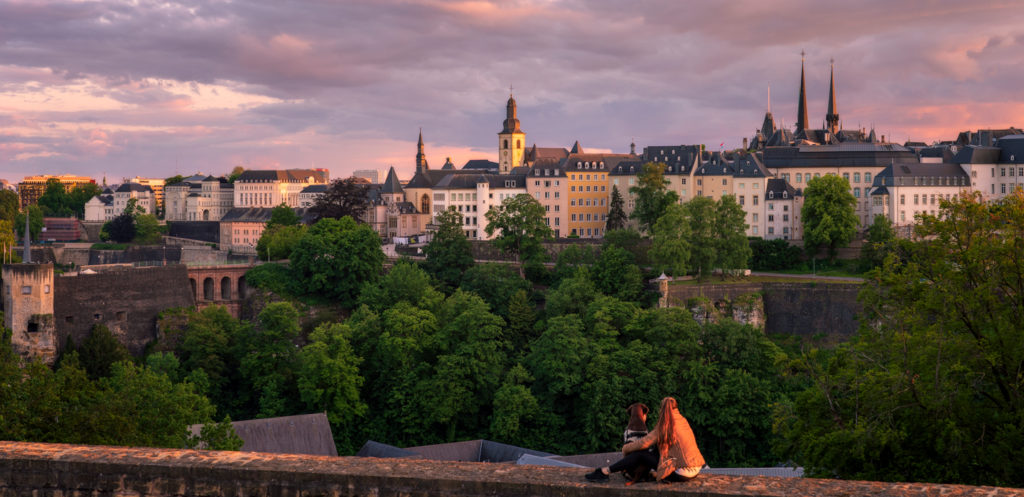AS I parked my e-bike and tucked into a huge plate of spaghetti bolognaise at the youth hostel overlooking the lake in Luxembourg’s oldest city, I was aware I had missed one of the most fascinating sights in Europe.
Every year, on Whit Tuesday, some 40,000 energetic pilgrims and spectators from across the globe gather in Echternach for the ‘Hopping Procession’ in honour of St Willibrord, the Irish-ordained priest credited with spreading Christianity, miraculously curing the sick and founding the town and the church that became today’s magnificent (and much-rebuilt) abbey in 698.
Born near York, the young Willibrord left home for Ireland to spend 12 years becoming a missionary monk at the famed ecclesiastical settlement of Rath Melsigi, Garryhundon, in Co. Carlow, before moving to the heart of Europe where his zeal and achievements resulted in him becoming the Patron Saint of Luxembourg with his tomb in Echternach still being revered to this day.
 James takes a breather in the rolling hills near Steinheim
James takes a breather in the rolling hills near SteinheimIndeed, Irish pilgrims have attended the ‘Hopping Procession’ in recent years and a bone from his body is on permanent display in the Cathedral of Assumption in Carlow town , having been presented by Luxembourg in thanks for the Irish training and missionary zeal instilled in the country’s cherished saint.
Likened to Irish jigging or even Harlem’s African American Lindy Hop, the Luxembourg hopping tradition dates from pagan times and has been banned in the past by such Church luminaries as the 18th century Archbishop Wenceslas and even by the occupying Nazis in World War II.
But since the Germans were sent packing by Allied forces in 1945, it has been back and looks to be quite a sight.
Those many thousands of musicians beat out a polka melody as the procession of abbots, bishops and pilgrims - mostly dressed in white tops and dark trousers – hop their way through the medieval streets to the abbey crypt, passing St Willibrod’s tomb in lively reverence.
The ancient – possibly pagan - hopping is simple to learn and involves a little jump to the right, a little jump to the left, and hopping forward with white handkerchiefs being held between the hoppers to keep them in synch.
I made a diary note with my partner and photographer (and fellow e-biker) Sue Mountjoy to join the many spectators who will turn up in June this year to witness Europe’s most extraordinary procession in action.
 Hopping pilgrims in Echternach (Pic: LFT-Pancake!_100)
Hopping pilgrims in Echternach (Pic: LFT-Pancake!_100)If you are considering joining us there, I can recommend a few days spent cycling (e-biking if you, like us, are of a certain age!) through the Mullerthal region in eastern Luxembourg and known as ‘Little Switzerland’ for its ancient fairytale forests, roaring streams, mysterious sandstone gorges and some of the best cycle tracks in Europe.
We arrived there after a comfortable DFDS ferry ride from Dover to Dunkirk and a four-and-a-half hour drive along some of Belgium and Germany’s swift and largely uncongested E-roads.
Our base was the charming little Hotel Gruber, in sleepy Steinheim village, run by the same family for three generations and one of those gems of comfort, peaceful warmth, civility and high quality cuisine – a combination that has become ever rare in modern travel.
Our hired e-bikes awaited us in the hotel’s secure garden shed and we undertook three rides, graded at an intermediate level of difficulty on the free and easy-to-follow Komoot app that we used to navigate on our smartphones.
These started with an easy 10-mile route along the lively river Sure, which marks the border between Luxembourg and Germany, and took us to Hinkel for a strong local beer (9 per cent) as well as the beautiful 14th century Chapel of Girsterklaus, the oldest centre of pilgrimage to the Virgin Mary in the Grand Duchy and adorned with some fine frescoes.
After a fine supper, the late evening tradition in Steinheim is spent on the hotel’s pleasant terrace watching the sleepy world go by (don’t expect any Ibiza-style clubbing there!).
 Quirky pieces at one of the city's flea market stalls
Quirky pieces at one of the city's flea market stallsNext day we were up early to our second ride, 15 miles along the river again to pretty and very walkable Echternach, with its cobbled main square and labyrinthine side streets, the fascinating abbey and the nearby artificial lake with its lively and friendly youth hostel serving filling and cheap meals.
Onwards, we took the creek trail through the twisting wooded valleys, carved by rivers into the local sandstone and packed with gorges and gargoyle-like formations, before reaching the lively climbing, walking and cycling village of Berdorf.
There we stayed overnight at the hip and interestingly named Hotel Trail Inn Natur and Sporthotel, where the vibe was decidedly lively and packed with all kinds of outdoor enthusiasts sporting their finest Fjallraven tracksuits and coats and tucking into the decent draught beers and substantial grub offering.
Our gear had been forwarded by a specialist operator (MoveWeCarry), so the next day, after a huge alpine breakfast (well, we were at 1200 feet above sea level) we headed off on a more challenging 21-mile ride back down the hill to the Hotel Gruber.
This included a stop at the ruins of 11th century Beaufort Castle as well as lunch in Echternach and another fine supper at the Hotel Gruber, where an extensive wake reception had been held for a local man who had died at the age of just 40,
As we bade goodbye the next morning to the delightful Hotel Gruber family and other guests from Luxembourg, France and Germany, we felt we had entered a world of old-style courtesy and friendliness steeped in the nature and mystery of a unique region and country.
As for that Hopping Procession of Echternach? See you there in June!
 An evening view of Luxembourg city
An evening view of Luxembourg city
Luxembourg City
Now a Grand Duchy and one of the world’s wealthiest countries, Luxembourg has been invaded, occupied and chopped up more times than a hen house with a fox covert for a neighbour.
Franks, Romans, French, Belgians, Germans...they’ve all come over the border and left again, taking some of the original land with them.
Little wonder that the capital, Luxembourg City, with a population of 134,000 - 70 per cent of them being foreigners - is such a treasure house of varied architecture, international food, languages, verdant public gardens and cultures from across Europe and the world.
The city’s famed finance sector draws workers from across the globe and even commuters from across the German, French and Belgian borders to work in the modern tower blocks of Kirchberg, occupied by some of the world’s powerhouse businesses, from Amazon to EU institutions.
On a fascinating e-bike tour of the highly walkable city, I was able to travel round the old town, perched high on an escarpment which once made the city a formidable stronghold. Here was the twin-spired cathedral, the deep tunnels carved by the Spanish in the 1600s as defensive emplacements and the Grand Duke’s opulent palace.
In fact, from a quirky flea market (I bought some original Radio Luxembourg stickers for 3 euros) to the park coffee kiosks, world-standard restaurants and stacks of museums, galleries and lively cafes, this very lovable city has everything for a fascinating weekend break.
Accommodation
Hotel Parc Plaza is central and very comfortable with a lofty terrace restaurant.
Hotel Gruber booking and information here.
Factfile
Further information on visiting Luxembourg here.
E-bike hire information here.
Baggage forwarding services here.
Public transport is free throughout the city and country and English (as well as French, German and the local language Luxembourgish).
Travel
DFDS has up to 30 crossings per day on its Dover to Calais service and up to 24 daily sailings from Dover to Dunkirk.
Fares start at £80 one way for a car and up to four people, with day trip and short break fares also available throughout the year starting at £39 return.
The Premium Lounge offers complimentary hot and cold drinks, sandwiches, and snacks from £18 per person.
Looking for airport parking, hotels and lounges and hotels in Dover and other ports? Holiday Extras offer major savings compared to prices on the gate.

